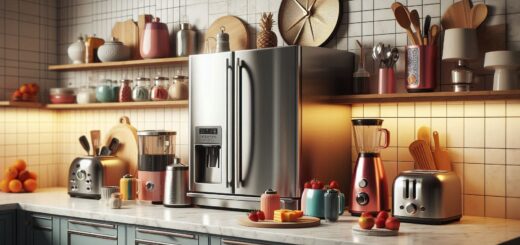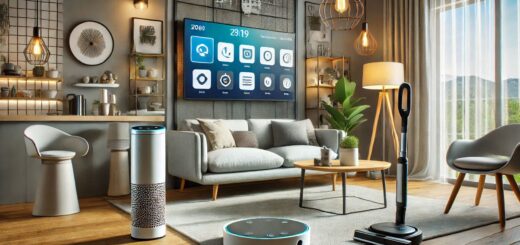Top 10 Home Automation Ideas for Busy Families
Modern life is busier than ever, and for many families, juggling work, school, extracurricular activities, and household responsibilities can feel overwhelming. Thankfully, home automation can help alleviate some of the stress, making day-to-day tasks easier and freeing up valuable time. Here’s a deep dive into the top 10 home automation ideas that can make a big difference for busy families.
Table of Contents
What is Home Automation?
Home automation, also known as smart home technology, involves the integration of connected devices and systems within a home that can be controlled and monitored remotely, often through a smartphone, tablet, or voice commands. The central concept of home automation is to make everyday tasks more efficient, convenient, and secure by automating the operation of various household functions.
Key Components of Home Automation:
- Smart Devices: These include smart lights, thermostats, locks, cameras, and appliances, which are designed to communicate with each other and can be operated remotely or according to set schedules.
- Centralized Control: Many home automation systems are controlled via apps or hubs, such as Google Home, Amazon Alexa, or Apple HomeKit, where users can manage and monitor all connected devices from one platform.
- Automation: Devices can be programmed to act automatically based on certain triggers or schedules. For example, a smart thermostat can adjust your home’s temperature when it detects you’re on your way, or smart lights can turn off when you leave the house.
Benefits of Home Automation
- Convenience: Simplify daily tasks by controlling lights, locks, and appliances remotely. You no longer have to worry about turning off the lights before bed or adjusting the thermostat when you’re away.
- Energy Efficiency: Smart thermostats, lights, and appliances help reduce energy consumption by adjusting settings based on your habits, occupancy, or time of day.
- Enhanced Security: Home automation can improve security through smart cameras, motion sensors, doorbell cameras, and smart locks. These systems provide real-time alerts and enable remote monitoring.
- Increased Comfort: Devices can create a personalized living environment, such as adjusting the lighting and temperature to your preferences. Automated schedules ensure that your home always feels comfortable without manual adjustments.
- Remote Monitoring: Even when you’re away from home, you can check on your property, adjust settings, or receive alerts if something unusual happens. This is particularly beneficial for families with busy schedules or for monitoring kids or pets.
10 Home Automation Ideas to Simplify Life for Busy Families
Here are 10 home automation ideas that can make life easier for busy families, providing convenience, energy savings, and enhanced security. By integrating these solutions, you can streamline daily tasks, reduce stress, and improve your home’s efficiency, making it easier to manage busy schedules.
1. Smart Lighting Solutions
Lighting plays a significant role in creating a comfortable and functional home environment. With smart lighting, you can control brightness, schedules, and colors, adding convenience, ambiance, and energy efficiency to your home. These lighting systems can be integrated with other smart home devices, allowing for seamless automation and a fully customized lighting experience.
Motion-Activated Lighting
Installing motion sensors ensures that lights turn on only when needed. This eliminates the need to manually control lights, which is especially useful in hallways, bathrooms, or garages, where lights are often left on by mistake. The automatic activation saves energy by ensuring lights aren’t left running when rooms are unoccupied, offering both convenience and sustainability.
Voice-Controlled Lights
Voice-controlled systems like Amazon Alexa or Google Assistant make managing your home’s lighting easy and hands-free. With simple commands like “Turn off the living room lights” or “Dim the kitchen lights,” you can control your lights without ever needing to touch a switch. This feature is ideal for busy families, particularly when your hands are full or when you want to adjust the lighting from a distance.
Scheduled Lighting for Morning and Night Routines
You can program your lights to mimic the natural light cycle. In the morning, set your lights to gradually brighten and mimic sunrise, which helps to wake you up gently, promoting a more relaxed start to the day. In the evening, schedule your lights to dim gradually, creating a soothing atmosphere that signals it’s time to wind down for bed. These routines can also be linked with other smart home features, such as adjusting your thermostat or playing relaxing music, to enhance your overall daily routine.
By incorporating these smart lighting solutions, you can create a more functional, energy-efficient, and enjoyable living space that fits your family’s unique lifestyle.
2. Automated Climate Control
Keeping your home at the ideal temperature while saving on energy bills is now easier with automated climate control systems. These smart devices help maintain comfort and efficiency, adapting to your family’s needs and schedules, ensuring that your home remains cozy and energy-efficient year-round.
Programmable Smart Thermostats
Devices like Nest, Ecobee, and Honeywell’s smart thermostats can learn your family’s routines and adjust temperatures accordingly. These systems monitor your home’s temperature, activity levels, and outside weather to make real-time adjustments. For example, they can lower heating or cooling while you’re away, and then raise or lower it before you return, ensuring a comfortable environment without wasting energy. With features like geofencing, the thermostat can even detect when you’re leaving or returning home, making temperature adjustments automatically, without any extra effort.
Room-Specific Temperature Settings
One of the key benefits of smart climate control systems is the ability to set different temperatures for individual rooms. Many smart thermostats now offer zoned heating and cooling, which is ideal for large families or households with varied comfort preferences. Whether someone likes their bedroom cool and another prefers a warmer living room, you can tailor the temperature for each area of your home. This helps eliminate the common problem of having a one-size-fits-all temperature for the entire house, providing a more personalized experience for everyone.
Eco-Friendly Energy-Saving Modes
Many modern thermostats come equipped with energy-saving modes, which can be activated when the house is unoccupied. By automatically adjusting the temperature to more energy-efficient settings, these modes significantly reduce heating and cooling costs. For example, when you leave for work or vacation, the thermostat can shift to an eco-friendly mode, lowering the temperature in winter or raising it in summer. This not only helps save on utility bills but also contributes to a more sustainable household, reducing your carbon footprint.
By integrating automated climate control into your home, you can maintain the perfect temperature throughout the day, save on energy costs, and reduce the effort required to manage your home’s environment. These systems make it easier to ensure a comfortable, energy-efficient home for your family while minimizing unnecessary energy consumption.
3. Voice-Activated Assistants
Voice-activated assistants serve as the central hub of your smart home, helping manage tasks effortlessly and making daily life more convenient. These systems allow you to control various devices, create routines, and perform hands-free tasks, saving time and simplifying household management.
Centralized Voice-Control Hubs
Systems like Amazon Echo, Google Nest, and Apple HomePod enable you to control multiple smart devices with a single voice command. Whether it’s turning on the lights, adjusting the thermostat, or controlling entertainment systems, you can manage it all hands-free. These hubs act as the brain of your smart home, connecting all your devices and streamlining daily activities. For example, you can say, “Alexa, turn off the lights and set the temperature to 72°F,” and the assistant will carry out multiple tasks simultaneously.
Integrating Virtual Assistants with Other Smart Devices
One of the key advantages of voice-activated assistants is their ability to integrate with other smart devices, providing seamless automation across your home. You can sync your voice assistant with devices like smart refrigerators, robotic vacuum cleaners, security cameras, and even kitchen appliances. For instance, you could ask your assistant to start the washing machine or lock the doors while you’re leaving the house. Integrating these systems enables you to perform complex tasks with simple voice commands, making home management more streamlined and reducing the need for manual control of each device.
Popular Options: Alexa, Google Assistant, Siri
When selecting a voice-activated assistant, it’s essential to consider the system that aligns best with your family’s needs and preferences. Amazon Alexa is known for its vast compatibility with third-party smart devices and services, making it a popular choice for larger, more connected homes. Google Assistant excels in providing natural language processing, making it excellent for tasks that require a conversational tone. Apple’s Siri, while more limited in third-party integrations, offers strong privacy features and works seamlessly with other Apple devices. Each system has unique strengths, so it’s important to evaluate which one fits best with your existing technology ecosystem.
By implementing a voice-activated assistant, you can create a more efficient and connected home. It reduces the time and effort spent on manual controls, providing more time for family activities and less stress over managing everyday tasks.
4. Smart Kitchen Appliances
Cooking and meal prep become hassle-free with smart appliances that save time and effort, allowing you to focus more on enjoying your meals and less on the preparation process. These devices bring convenience, efficiency, and innovation to your kitchen, transforming the way you cook, store, and clean.
Automatic Coffee Makers
Start your day with ease by programming your smart coffee maker the night before. Set it to brew your coffee at a specific time, and you’ll wake up to the aroma of freshly brewed coffee without lifting a finger. Many models allow you to customize brewing strength, temperature, and even the type of coffee you prefer. For those with busy mornings, this feature ensures that your coffee is ready exactly when you need it, making your morning routine much smoother.
Recipe-Assisting Smart Displays
Devices like the Amazon Echo Show or Google Nest Hub provide step-by-step recipe instructions, making cooking easier for even beginner chefs. These smart displays can show video tutorials or detailed text instructions, allowing you to follow recipes without needing to touch your screen with messy hands. In addition, they can integrate with your oven or other smart kitchen devices, automatically adjusting settings like temperature or cooking time based on the recipe you’re following. This can help reduce cooking errors and ensure your meals come out perfect every time.
Inventory-Tracking Refrigerators
Smart refrigerators take kitchen organization to the next level. These fridges come with built-in inventory tracking, allowing you to monitor the contents of your fridge remotely via an app. Many smart fridges can scan barcodes and track expiration dates, sending you reminders when it’s time to use up ingredients before they spoil. Some models even suggest recipes based on the ingredients you have on hand, minimizing food waste and helping you plan meals efficiently. This feature is especially useful for families, as it ensures you never run out of essential items and always have ideas for what to cook.
By incorporating smart kitchen appliances, you can simplify meal prep, reduce food waste, and enhance the overall cooking experience. These devices offer convenience, helping families save time and energy, while making your kitchen smarter and more efficient.
5. Home Security Systems
Ensure your family’s safety with intelligent security systems that provide peace of mind, offering enhanced protection and control over your home’s safety. These systems integrate smart technology to monitor your property, detect potential threats, and allow remote management, all while reducing the risk of break-ins and ensuring the well-being of your loved ones.
Smart Doorbells with Cameras
Smart doorbells, such as Ring or Nest Hello, come equipped with HD cameras and two-way communication, allowing you to see and speak to visitors remotely. Whether you’re at home or away, you can monitor who is at your door through your smartphone or smart display. This feature is particularly useful for screening visitors, packages, or even delivery personnel without needing to open the door. Additionally, these devices often come with motion sensors, so you’ll receive alerts whenever someone approaches your door, ensuring you’re always aware of activity at your entrance.
Automated Door Locks
Say goodbye to the hassle of carrying keys with smart door locks. These locks can be operated remotely through apps or with biometrics like fingerprint scanning, allowing you to lock or unlock doors with a simple command. Automated locks are not only convenient but also add a layer of security by offering features such as remote access for trusted family members or guests. You can give temporary access codes for service workers or visitors and monitor entry logs to track who comes and goes. This level of control ensures that only authorized individuals can enter your home, enhancing overall security.
Motion and Intrusion Sensors
Motion sensors and intrusion alarms are essential for detecting unusual activity around your home. These sensors can be installed both indoors and outdoors to monitor areas such as entryways, windows, or the perimeter of your property. If any movement is detected when the system is armed, you’ll receive real-time alerts on your smartphone. Some systems even allow you to view live footage from security cameras, giving you a full picture of what’s happening. These sensors can help protect against intruders, prevent false alarms, and give you immediate updates in case of a break-in attempt.
By implementing a smart home security system, you can create a safer environment for your family. These systems provide not only enhanced protection but also added convenience and peace of mind by allowing you to monitor and manage your home’s safety remotely, from anywhere at any time.
6. Entertainment Automation
Take your family’s entertainment experience to the next level with smart automation, offering seamless control over your media devices and creating a personalized, immersive atmosphere for all your entertainment needs. With smart technology, you can enhance your movie nights, gaming sessions, and streaming experiences with ease and convenience.
Smart TVs and Streaming Services
Smart TVs allow you to control streaming platforms like Netflix, Disney+, Hulu, or Amazon Prime Video with your voice or through an app. With a smart TV, you can instantly access your favorite shows, movies, and music without the need for extra remote controls or devices. By setting up personalized viewing profiles, each family member can have their own tailored content recommendations and preferences. This feature is particularly useful for households with diverse entertainment tastes, ensuring that everyone can easily find and enjoy what they love.
Pre-Set Surround Sound Systems
Transform your living room into a home theater with pre-programmed surround sound settings. With smart home integration, you can tailor your sound system for movie nights, sports events, or music sessions. Many systems allow you to set and save sound profiles for different types of content, such as an immersive movie experience or enhanced audio for music. With automation, the system can adjust itself based on what you’re watching, ensuring optimal sound quality without any manual adjustments. You can even control it with voice commands, further elevating the experience.
Voice-Controlled Gaming Consoles
For families who enjoy gaming, voice-controlled gaming consoles provide a hands-free, streamlined experience. Devices like Xbox and PlayStation, when integrated with voice assistants like Alexa or Google Assistant, allow you to turn on the console, select games, adjust volume, or switch between gaming modes using simple voice commands. You can also control settings such as brightness, contrast, or sound without interrupting your gameplay, making it easier to focus on the fun. This is especially convenient for busy parents and kids who want to quickly set up their gaming systems without fumbling with multiple controls.
By integrating entertainment automation into your home, you can simplify and enhance how you watch TV, listen to music, and enjoy gaming, creating a more enjoyable, customized experience for your family. The convenience of voice control, personalized settings, and streamlined automation helps ensure that your family’s entertainment needs are met with minimal effort.
7. Automated Cleaning Devices
Cleaning doesn’t have to eat into your precious family time when you can rely on smart devices to handle the job for you. With the help of automated cleaning devices, your home can stay spotless and organized with minimal effort, giving you more time to focus on other important activities and enjoy quality time with your family.
Robotic Vacuum Cleaners
Robotic vacuum cleaners like Roomba are a game-changer for busy households. These devices can be scheduled to clean your floors daily or at specific times, so your home is consistently tidy without lifting a finger. Many models have advanced sensors that help them navigate around furniture, avoiding obstacles and ensuring thorough cleaning of every corner. With app integration, you can control the vacuum remotely, set cleaning schedules, and even track its progress. For families with pets or children, robotic vacuums are especially beneficial for keeping your floors clean of dust, dirt, and pet hair.
Self-Cleaning Litter Boxes
For pet owners, automated litter boxes can significantly reduce the time and effort spent on cleaning up after pets. These smart devices automatically scoop waste into a sealed compartment, ensuring that your pet’s litter box is always clean and odor-free. Some models even have features like health monitoring, alerting you if there are any unusual changes in your pet’s waste, providing valuable insights into their well-being. With a self-cleaning litter box, you no longer have to worry about daily scooping or unpleasant smells, leaving you with more time to bond with your furry companions.
Window-Cleaning Robots
Window-cleaning robots are the perfect solution for families with large or hard-to-reach windows. These robotic devices attach to windows and use suction or magnetic technology to move across the glass, removing dirt, dust, and smudges without any effort on your part. Many models can be controlled via smartphone apps, allowing you to schedule cleaning sessions or start them remotely. Whether it’s windows on a high floor or large sliding glass doors, these robots ensure that your windows stay sparkling clean, enhancing the overall look of your home without the need for ladders or manual labor.
By integrating automated cleaning devices into your home, you can simplify household chores and maintain a tidy living space without sacrificing time or effort. These devices provide more freedom for your family, allowing you to spend time on activities that matter most while maintaining a clean and organized home.
8. Garden and Lawn Care Automation
A well-maintained yard doesn’t have to be labor-intensive, thanks to smart gardening tools that take the effort out of landscaping and lawn care. With automated systems, your garden and lawn can remain healthy and beautiful without constant manual attention, leaving you with more time to enjoy your outdoor space.
Smart Sprinkler Systems
Smart sprinkler systems, such as Rachio or RainMachine, allow you to control watering schedules and adjust settings based on real-time weather conditions. These systems can automatically detect rainfall and adjust watering times accordingly, ensuring that your lawn gets the right amount of water without over-watering or wasting resources. By monitoring weather forecasts and tracking soil moisture levels, smart sprinklers help optimize water usage and promote a healthy, green lawn while conserving water. You can also control and schedule watering remotely through an app, providing flexibility and convenience.
Robotic Lawn Mowers
Robotic lawn mowers, like the Husqvarna Automower or Worx Landroid, take over the task of mowing your lawn, ensuring your grass is always neatly trimmed without requiring your time or effort. These mowers work autonomously, navigating around obstacles and adjusting their mowing patterns for a clean, even cut. Many robotic mowers are equipped with sensors that help them detect edges and avoid obstacles such as flower beds, making them ideal for a variety of yard sizes and shapes. You can set up mowing schedules, and the mower will return to its charging station when its battery is low, ensuring your lawn remains well-maintained without intervention.
Plant Monitoring Sensors
For garden enthusiasts, plant monitoring sensors provide valuable insights into your plants’ health and needs. These sensors track soil moisture, temperature, and nutrient levels, sending alerts to your smartphone when your plants require attention. Whether you have a flower garden, vegetable patch, or indoor plants, these sensors help you maintain optimal conditions for plant growth. By receiving timely notifications, you can ensure that your plants are always properly watered and fed, preventing over- or under-watering and maximizing their health and vitality.
By incorporating garden and lawn care automation into your outdoor maintenance routine, you can keep your yard in excellent condition with minimal effort. These smart systems and devices help save time, conserve resources, and provide a more efficient way to care for your garden, allowing you to spend more time enjoying your outdoor space.
9. Automated Home Office Setup
For families balancing remote work, homeschooling, or other at-home responsibilities, a smart office setup can significantly improve productivity and comfort. With the right tools, you can create a flexible, efficient workspace that enhances focus, encourages healthy work habits, and helps everyone stay organized throughout the day.
Height-Adjustable Smart Desks
Height-adjustable smart desks, such as those from Fully or Autonomous, allow you to effortlessly switch between sitting and standing, promoting better posture and reducing the health risks associated with prolonged sitting. These desks can be programmed to automatically adjust to your preferred sitting and standing heights, making it easy to move between positions throughout the day. Some models even come with memory presets, so you can easily return to your ideal settings with the push of a button. This flexibility ensures that your workspace is always tailored to your needs, providing comfort and supporting productivity during long work or study sessions.
Smart Lighting for Productivity
Lighting plays a significant role in maintaining focus and productivity. Smart lighting systems, like Philips Hue or LIFX, allow you to adjust the brightness and color temperature of your workspace to suit different tasks and times of day. During the morning, you can set your lights to cool, bright tones that help boost alertness and focus. In the evening, you can switch to warmer tones to create a relaxing ambiance that promotes relaxation and reduces eye strain. By integrating lighting into your routine, you can create an environment that enhances your mood and supports your workflow.
Noise-Cancelling Devices
Creating a distraction-free environment is essential for maintaining focus in a busy household. Smart speakers, headphones, or noise-cancelling devices can help block out background noise and ensure you can concentrate on your tasks. Devices like the Bose Noise Cancelling Headphones or smart speakers with built-in white noise or sound masking features can drown out distractions like household noise, pets, or conversations. This is especially useful for remote workers or students who need a quiet space to concentrate. Noise-cancelling technology ensures a more peaceful and productive atmosphere, allowing you to fully immerse yourself in work or study without interruptions.
By setting up an automated home office with these smart devices, you can create a more comfortable, efficient, and focused environment for remote work, homeschooling, or any other at-home tasks. These tools help support productivity, encourage healthy work habits, and improve your overall experience while working or studying from home.
10. Health and Wellness Automation
Support your family’s well-being with devices that promote healthier living and encourage positive lifestyle habits. By incorporating smart technology into your health routines, you can ensure better air quality, fitness, and sleep, all of which contribute to improved physical and mental wellness for your family.
Smart Air Purifiers
Smart air purifiers, such as those from Dyson or Molekule, help improve the air quality in your home by automatically removing allergens, pollutants, and harmful particles from the air. These purifiers use sensors to detect the air quality and adjust their settings accordingly, ensuring optimal purification. Whether it’s pet dander, pollen, or smoke, smart air purifiers work continuously to provide clean, fresh air. Many models are app-enabled, allowing you to monitor and control air quality remotely, ensuring that your family breathes healthier air, especially in rooms where allergies or respiratory issues are a concern.
Fitness Trackers and Home Gyms
Fitness trackers like Fitbit, Apple Watch, or Garmin allow you to track physical activity, monitor heart rate, and set health goals for each family member. These devices provide insights into activity levels, sleep quality, and overall fitness progress. For those with home gym equipment, fitness trackers can be integrated with devices like Peloton, Zwift, or other smart gym machines, providing a seamless fitness experience. Whether you’re tracking daily steps, workouts, or calories burned, smart fitness devices help keep you motivated and committed to maintaining an active lifestyle. Additionally, they can provide personalized workout suggestions based on your goals and progress.
Automated Sleep Assistance Systems
Sleep is a crucial part of overall health and well-being, and automated sleep assistance systems can help ensure your family gets the rest they need. Devices like the Sleep Number bed or Hatch Restore monitor sleep patterns and adjust temperature, lighting, or sound to optimize sleep quality. These systems can automatically adjust to your ideal sleep environment—whether it’s a cool room temperature, white noise, or gentle lighting that gradually dims as you fall asleep. Smart pillows, beds, and sound machines can be integrated into your sleep routine to create the perfect environment for restful nights. These systems help track sleep quality over time, providing feedback and adjustments for better sleep and overall health.
By integrating health and wellness automation into your home, you can promote a healthier lifestyle for your family with minimal effort. These devices support better air quality, physical fitness, and sleep, which are essential components of overall well-being. With the help of smart technology, you can ensure your family’s health is always a priority while maintaining a comfortable, balanced environment.
Integrating Systems for Maximum Efficiency
To maximize the benefits of home automation, integrating your various smart systems is key. This allows you to have seamless control and coordination across different devices, creating a more efficient and cohesive smart home environment. However, achieving this requires careful planning and thoughtful choices about the platforms and devices you use.
Choosing the Right Ecosystem
Selecting the right ecosystem is the first step in ensuring your smart home devices work together smoothly. Popular platforms like Apple HomeKit, Google Home, or Amazon Alexa provide centralized hubs where you can control multiple devices from a single interface. Each ecosystem offers unique features and compatibility with a wide range of devices, so it’s important to choose one that aligns with your family’s preferences and the devices you plan to use. A well-chosen ecosystem will allow you to integrate everything from lighting and climate control to security and entertainment systems, ensuring all devices work in harmony.
Compatibility Across Devices
Before purchasing new devices, it’s essential to check for compatibility with your existing system. Not all smart devices are created equal, and some may not integrate well with others. For example, some devices may only work with certain ecosystems or may require additional hubs or bridges to connect to your central system. To avoid connectivity issues and frustration, always check the manufacturer’s specifications for compatibility, or opt for devices that are designed to work together seamlessly within the same ecosystem. This can prevent the need for multiple apps and devices to manage, keeping your smart home experience as streamlined as possible.
Using Apps to Manage All Systems
To simplify control, consider using apps that allow you to manage all your devices from one central location. Many ecosystems offer apps, like the Google Home app, Apple Home, or Amazon Alexa app, which let you control everything from lighting to security and climate systems. These apps enable you to set routines, adjust settings, and monitor device status, all from your smartphone or tablet. You can also create customized automation routines that link various devices together, such as having your thermostat adjust when you arrive home or dimming the lights when you start a movie. By using a centralized app, you can efficiently manage your entire smart home from one interface, ensuring that all systems are working together for maximum convenience and efficiency.
FAQs on Home Automation Ideas
1. What is the cost of setting up home automation?
The cost of setting up home automation varies widely depending on the complexity and scope of the system. For basic systems, such as smart lighting or individual devices like thermostats, the cost may range from a few hundred dollars. More advanced setups, involving multiple interconnected devices, security systems, or integrated home ecosystems, can cost several thousand dollars. The price can also vary based on brand, features, and professional installation.
2. Are home automation systems secure?
Yes, home automation systems can be secure, but it’s crucial to take the necessary steps to protect your devices and data. Ensure that you regularly update the software and firmware of your smart devices to patch any security vulnerabilities. Additionally, using strong, unique passwords and enabling two-factor authentication (if available) adds an extra layer of protection. Some systems may also offer end-to-end encryption, which helps secure your data.
3. Can I install home automation devices myself?
Many home automation devices are designed to be DIY-friendly, with easy-to-follow instructions and setup through mobile apps. Devices like smart thermostats, lights, and plugs are often simple to install. However, for more complex systems, such as integrated security systems or whole-house automation, professional installation may be recommended to ensure proper setup, wiring, and functionality.
4. Will home automation save money in the long run?
Yes, home automation can help save money in the long run. Energy-efficient systems, like smart thermostats and lighting, can reduce utility bills by optimizing energy use. Devices like smart sprinklers and home security systems can also help prevent waste, lowering overall costs. Additionally, time-saving devices, like robotic vacuum cleaners or automated cleaning systems, can free up time for other tasks, potentially reducing the need for external services.
5. Do smart devices require Wi-Fi?
Most smart devices require a stable Wi-Fi connection to function properly, as they rely on cloud services or remote control via apps. However, some devices use alternative communication protocols like Zigbee or Z-Wave, which don’t necessarily require Wi-Fi. These protocols allow devices to communicate with a hub or gateway, which then connects to the internet. In some cases, certain smart devices may also work offline with limited functionality.
6. What happens to automated systems during a power outage?
During a power outage, many home automation systems may lose functionality due to the lack of electricity. However, some devices, such as smart thermostats or security cameras, may have backup power options like batteries or uninterruptible power supplies (UPS). Devices that rely solely on electricity, such as smart lights or appliances, will likely be non-functional until power is restored. It’s important to check for backup power options when purchasing devices to ensure minimal disruption during power failures.
Conclusion
Home automation offers a range of solutions to simplify life for busy families. From managing lighting and climate to enhancing security and entertainment, these systems save time, reduce stress, and improve the overall quality of life. Start with one or two ideas from this list and expand as you see fit—automation truly is the future of home living.












